Coastal colour
Here in the ‘Land of the Long White Cloud’ few of us live far from the sea, which means many of our gardens feel the effects of the ocean, to a greater or lesser degree.
Apart from the obvious joys of living near the sea, those closest have the advantage of a balmy frost-free climate. But coastal gardening is not without its challenges. The soil can be less than ideal. And worse, there’s that punishing salt laden wind.
The good news is that many of our native plants evolved to cope with coastal exposure. Also at our disposal, we have hundreds of Australian, South African and Mediterranean plants that thrive in our coastal gardens. Wind tolerant plants tend to have a certain look about them. Hard, thick or waxy leaves, and small or narrow needlelike leaves are features that reduce moisture loss in drying winds or decrease wind resistance.
Growth habit is another clue; a plant is better equipped to survive a howling gale if it is low and spreading or has strong flexible branches. Silver foliage is a strong indicator that you are looking at a shrub that will thrive in hot dry conditions.
Shelter first
Once a garden is effectively sheltered, a surprising range of plants can be grown, no matter how close it is to the coast. Shelter planting also protects the soil from erosion. Trees provide more effective shelter than solid walls, because they slow the wind down rather than deflecting and dumping it, and a good shelter planting can give protection for a distance of up to ten times its height. Some of the best shelter trees for NZ coastal conditions are natives; Pohutukawa, Karo (Pittosporum crassifolium), Olearia, Corokia and Griselinia.
Wind dancers
Flaxes, cabbage trees, and native tussock grasses are excellent for coastal sites, bringing movement and exciting textural contrast and they look fantastic mass planted on cliff tops. Such is the variety of different flax cultivars, its possible to have a wildly colourful garden without any flowers.
Striking in silver
Astelias are widely planted for their sculptural form and glistening silvery foliage. Astelia ‘Silver Spear’ and the finer leafed A. banksii will grow right up to the base of the sand dunes. Popular Astelia ‘Westland’ has attractive reddish-bronze leaves. Astelias will cope with harsh wind and frost, but dislike wet soil.
Ground huggers
When there’s a cold wind blowing it makes sense to lie low. And, when there’s a sea view to preserve, we need plants that grow sideways rather than up. The prostrate New Zealand native Coprosmas and Muehlenbeckias are ideal for coastal situations. Smooth bright green Scleranthus (moss plant) looks stunning with rocks. For dark foliage contrast we have the native Geraniums ‘Thundercloud’, ‘Pink Spice’ and ‘Purple Passion’.
Cliff hangers
Rengarenga lilies (aka rock lily or Arthropodium) grow wild on rock faces of the New Zealand coastline, their white flowers a picture in late spring. But a wild coastal cliff is no prerequisite for this great low maintenance plant. It’s a well- established favourite for mass planting in dry shady areas under trees. Varieties ‘Matapouri Bay’ and ‘Avalanche’ are superior selections of the wild form with thicker foliage, hence not as easily defaced by slugs and snails.
Exquisite Marlborough rock daisy (Pachystegia insignis) is native to the coastal cliffs of Marlborough and loved by gardeners both for its grey foliage and its summer daisy flowers. Excellent drainage is essential for this highly desirable perennial.
Beautiful Poor Knights lily (Xeronema) can take several years to bloom, but its spectacular scarlet brushes are worth the wait. In its natural habitat Poor Knights lily grows on exposed rocky outcrops where there is full sun, limited root space, scarce nutrition, extreme drainage and no frost. Such conditions are best imitated by growing it in a pot.
Out of Africa
Dry sandy soils and exposed cliff tops prevail in South Africa’s Cape Province, so it’s no surprise that many of our best coastal plants have come to us from this botanically rich region of the world. They include vibrantly coloured African daisies (Arctotis, Osteospermums and Gazanias), hot pokers (Knifophia) and bright fluro coloured Mesymbryanthemums. Also Proteas and Leucadendrons that range from dwarf shrubs to small trees. These shrubs are especially colourful in winter and combine well with NZ grasses and flaxes and Australian natives.
Aussie mates
Australian native plants are famously colourful and fond of poor, coastal soils. Among the most colourful are the Grevilleas. Their spider-like flowers cover an entire shrub in bright shades of red, orange, gold or cream, often in mid winter. Gevilleas range from ground carpets to large trees. Callistemon (Bottlebrush) forgives heavy soils, dry and windy conditions. There are many beautiful varieties including the reliable dwarf form “Little John”. Banksias make excellent shelter trees and their flowers are a valued source of winter nectar for birds. Dwarf forms, such as ‘Birthday Candles’ produce a fabulous show of flowers on ground creeping plants.
Lush looking Australian rush grasses (Lomandra) areextremely drought and heat tolerant, fantastic for mass planting or in pots. They come in various heights and shades of green to blue-green. Lomandra combines well in coastal gardens with clipped Westringia, the Aussie answer to rosemary.
Characterful Kangaroo Paws (Anigozanthus) produce velvety paw-shaped flowers in bright funky colours. New "high health" varieties are much more compact, and disease resistant than older forms, ideal for growing in pots and great with grasses.
Mediterranean style
A Mediterranean themed garden is fitting in a coastal setting. Silvery olives are the classic signature tree. Lavender, rosemary and rock roses (Cistus) are favourite flowering shrubs, while silver Teucrium fruticans is loved for hedges and topiary.
Convolvulus cneorum is a drought tolerant shrub, with sparkling silver-grey foliage and masses of white summer flowers. It’s great as an informal hedge. Aromatic herbs such as thyme, oregano, rosemary and sage grow well in dry sandy soils (or in pots).
For extra colour, fill terracotta pots or garden borders with brightly coloured geraniums (Pelargonium), border pinks (Dianthus) and sea thrift (Armeria). Read more about the latest pinks on page 32. The latest improved Armeria varieties include the ‘Bees’ series and the ‘Pretty Petites’.
Succulents
While all succulents cope with drought, many will also tolerate salty air. The big succulents Agave, Aloe, Yucca and Optunia (prickly pears) thrive in coastal gardens. Aeonium and Sedum varietiesalso love a hot seaside location.
Gardening by the sea
- Grow trees and tall shrubs to create shelter for you and your plants.
- Mix compost and controlled-release fertiliser with the soil at planting time.
- Use rocks to anchor and shelter plants and to protect their roots.
- Stake taller plants with two stakes on the windward side, one on the lee side, and protect with windbreak cloth until well established.
- Water in summer. Until they have their roots established, even drought tolerant plants need watering.
- Mulch to retain moisture. Seaweed makes good mulch.
18-Nov-2012

A coastal garden
...featuring cabbage trees, astelia, gazania, aloe, sedum, echium, westringia, coprosma, flax, aeonium and yellow daisies.
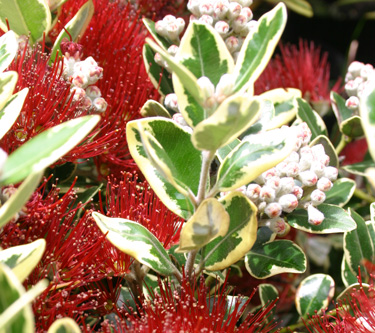
Variegated pohutukawa
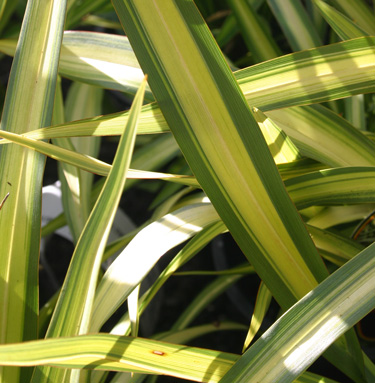
Flax - Phormium 'Yellow Wave'

Astelia Silver Spear
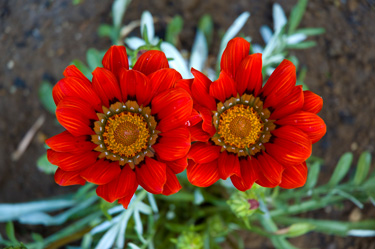
Gazania Takatu Red
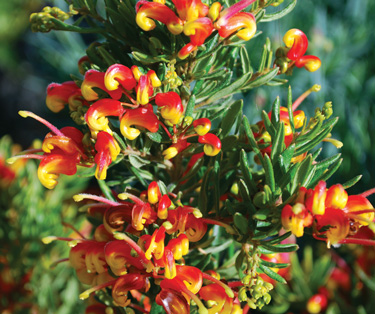
Grevillea Firecracker
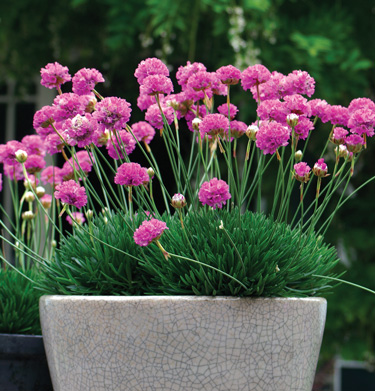
Sea Thrift - Armeria


